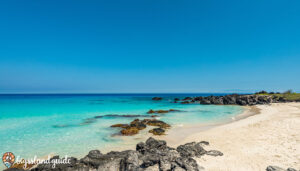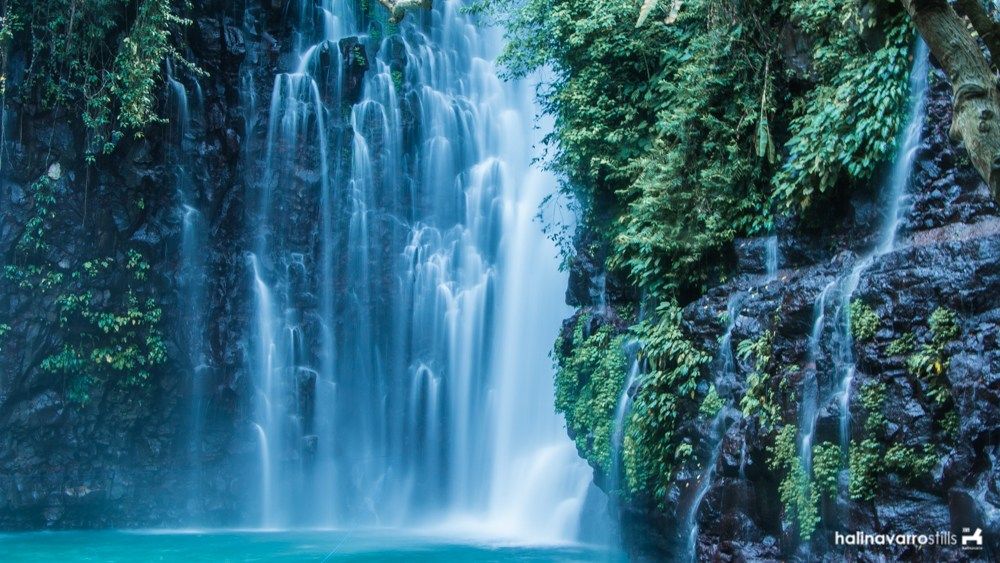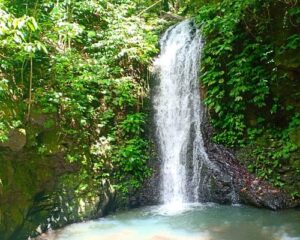Introduction to Manini’owali Beach: A tropical paradise
Sunbaked Manini’owali Beach on the sunny shores of Hawaii’s Big Island is no tropical dream with bright, crystal-clear waters combined with powdery white sand for a day of relaxation and exploration Creates an atmosphere. This beautiful beach is more than just a place to catch the sun; A haven for snorkelers and sunset lovers, it boasts the most vibrant underwater life Hawaii has to offer and spectacular sunsets.
This introduction is your gateway to the magic and light of Manini’owali Beach. Our goal? To pick the best spots for snorkeling and catching that perfect sunset, to make sure your visit to this slice of paradise is as magical as the scenery So, let’s dive in and let’s explore what a favorite jewel of Hawaii’s countless treasures Manini’owali Beach is.
Getting to Know Manini’owali Beach
Manini’owali Beach, often referred to as Kua Bay, is a spectacular coastal gem that graces the western shore of Hawaii’s Big Island. Tucked along the famed Kona Coast, this beach is synonymous with postcard-perfect vistas, drawing visitors from around the globe to its shores. Here, the geography is a vibrant display of nature’s artistry, with pristine white sands meeting the clear, azure waters of the Pacific, all beautifully contrasted against the rugged lava rock landscapes that are characteristic of the island.
Overview of Manini’owali Beach
The geography of Manini’owali Beach creates a paradisiacal setting that’s both inviting and awe-inspiring. Located just north of Kona International Airport, this beach boasts:
- White sand: So fine and powdery, it feels like walking on clouds.
- Clear blue water: Offering high visibility for snorkeling and swimming.
- Lava rock landscapes: Providing a dramatic backdrop against the tranquil beach.
These features come together to create a beach experience that’s both relaxing and visually stunning, making it a must-visit spot for anyone traveling to the Big Island.
What to Expect
When planning a visit to Manini’owali Beach, it’s helpful to know what to expect in terms of weather, seasonal variations, and facilities:
- Weather Conditions: The Kona Coast is known for its sunny days and mild climate year-round, making any time a good time to visit. However, mornings are generally calmer, with winds picking up in the afternoon.
- Seasonal Variations: While the beach is beautiful throughout the year, winter months may see stronger waves, appealing to surfers, while summer months offer calmer waters ideal for snorkeling.
- Beach Facilities: Visitors to Manini’owali can enjoy:
- Ample parking, though it can fill up quickly on busy days.
- Restroom facilities, ensuring comfort for all-day visits.
- Picnic areas, perfect for family outings or romantic picnics.
Understanding these elements before your visit can help you plan a more enjoyable and comfortable day at one of the Big Island’s most beautiful beaches. Whether you’re there to soak up the sun, explore the vibrant underwater world, or simply enjoy the breathtaking views, Manini’owali Beach offers a slice of paradise ready to be discovered.
Snorkeling at Manini’owali beach
Beneath the sparkling blue waters of Manini’owali Beach lies a hidden world teeming with life. Sparkling schools of tropical fish running among the coral reefs, peaceful floating sea turtles, and other exotic marine life provide a water a immersion here is truly an unforgettable experience
Best place for snorkeling
Although exciting snorkeling opportunities can be found all along the Manini’owali coast, some areas offer particularly interesting experiences due to the clarity of the water and the diversity of marine life Two top snorkeling areas go include:
- North end of the beach: Characterized by calm waters and an abundance of marine life, this area is perfect for beginners and snorkelers
- South Lava Rocks: This spot is often preferred by advanced snorkelers. Although it requires a very careful approach due to the presence of calcareous cliffs, it is rewarded with vibrant coral reefs and a great display of marine species.
Snorkeling tips and safety
Enjoying the underwater world at Manini’owali Beach is fun, but safety should be a priority. Keep in mind:
- Best time: Early morning is usually calm water and good visibility.
- Respect sea creatures: Avoid touching corals or sea creatures. Remember, you are a guest in their home.
- Potential hazards: Beware of strong currents, especially during the winter months, and always avoid sharp shells.
Armed with these tips, it helps create a safe and enjoyable snorkeling experience that respects the delicate aquatic ecosystem.
What You’ll See
Manini’owali’s underwater realm is colorful and diverse. As you explore, you might see:
- A variety of tropical fish, including Yellow Tang, Moorish Idols, and the unique-looking Picasso Triggerfish.
- Various species of sea turtles, including the Hawaiian Greens that are often seen gliding peacefully amongst the corals.
- Coral formations, including lobe coral and rice coral housing a variety of marine life.
- If you’re particularly lucky, you might even see Spinner Dolphins, known for their acrobatic displays above the water!
Snorkeling at Manini’owali Beach is like stepping into a living aquarium, filled with wonder at every turn. Just remember to always respect this delicate environment, ensuring it remains a paradise for future generations to enjoy.
Watching the Sunset at Manini’owali Beach
Witnessing the sunset at Manini’owali Beach is a transformative experience. The vibrant golds, fiery reds, and soothing blues that paint the evening sky create a spectacle of unmatched natural beauty. Here’s all you need to know about enjoying the captivating sunset on this magnificent beach.
Best Sunset Viewing Spots
The western-facing beach offers a panoramic view of the evening canvas, with every spot providing a delightful vista. However, certain locations at Manini’owali Beach are particularly unforgettable:
- Northern End: This quieter part of the beach offers uninterrupted sunset views, perfect for those seeking tranquility.
- Mid-Beach: Here, you’ll get a direct view of the sun setting over the horizon, with the gentle waves lapping on the shore adding to the ambiance.
When choosing your spot, consider the following tips:
- Arrive early to claim your space.
- Watch the tide, as high tide might restrict the beach areas.
Planning Your Sunset Visit
To enrich your sunset experience at Manini’owali Beach:
- Consider packing a picnic dinner to enjoy as you watch the day’s light fade away.
- Bring a blanket for comfort as the temperature can drop after sunset.
- Linger after the sun dips below the horizon. The changing colors in the sky continue to offer a delightful show.
- If you’re an experienced swimmer, consider an evening snorkel to experience the marine life in a whole different light.
- Above all, remember to relax, soak in the experience, and let the beauty of the sunset touch your soul.
Watching the sunset at Manini’owali Beach is more than just an activity—it’s a celebration of nature’s artistry that leaves every viewer inspired and awed. So savour every moment of this magical experience.
Planning Your Visit to Manini’owali Beach
A trip to Manini’owali Beach promises a serene blend of natural beauty, adventure, and relaxation. To maximize your experience, a bit of planning is key. Here’s a guide on when to visit, what to bring, and the local regulations to keep in mind.
When to Visit
Best Times of Year for Snorkeling and Sunset Viewing:
- Snorkeling: The best months are May through September when the water is calmer and clearer, offering better visibility of the vibrant marine life.
- Sunset Viewing: Sunsets are spectacular year-round, but the dryer months from May to October provide clearer skies for viewing the breathtaking hues.
Considering Weather and Visitor Volume:
- Weather: Summer offers the clearest skies and warmest water, albeit it’s the peak tourist season. The winter months can be a bit cooler and have rougher sea conditions.
- Visitor Volume: To avoid crowds, consider visiting on weekdays or during the off-peak seasons (fall and spring).
What to Bring
To ensure a comfortable and safe visit, here’s a checklist of essentials:
For Snorkeling:
- Snorkel gear (mask, snorkel, and fins)
- Water-safe sunscreen
- Waterproof camera or phone case
- Rash guard or protective swimwear
For Sunset Beach Visit:
- Blankets or beach chairs
- Flashlights or headlamps
- Light jacket (evenings can get cool)
- Snacks and water
Local Regulations and Etiquette
Manini’owali Beach is a treasure that requires our respect and care to preserve its natural beauty.
Beach Rules:
- No-Alcohol Policy: Alcohol consumption on the beach is prohibited.
- Trash: Practice “Leave No Trace” principles by packing out all trash and recyclables to keep the beach pristine.
Etiquette:
- Wildlife: Do not disturb the wildlife. Maintain a respectful distance from sea turtles and other marine life.
- Coral Reefs: Avoid stepping on or touching corals to prevent damaging these delicate ecosystems.
- Courtesy to Other Visitors: Keep noise levels down and share the beach and ocean respectfully with others.
Planning your visit to Manini’owali Beach with these pointers in mind will ensure a memorable and enjoyable experience while contributing to the preservation of this natural paradise for generations to come.
conclusion
Manini’owali Beach, thanks to its breathtaking picturesque scenery, presents a slice of heaven here on earth. The warm, turquoise waters teeming with vibrant marine life provide an unparalleled snorkeling experience. The beach also has some of the most aerial views of sunsets, where the colors of the sky leave a lasting impression on the canvas of the mind
Amidst the hustle and bustle of daily life, this beach is a serene oasis that allows visitors to create unforgettable memories. From joggers in the early morning, families in the afternoon, to contemplative souls enjoying the sunset, Manini’owali Beach touches lives with its natural beauty
However, while we enjoy these beautiful offerings, it is important that we do so responsibly. Keeping coastal laws in mind and maintaining garden etiquette, let’s strive to protect and preserve these natural flowers, leaving nothing to chance. We owe it to ourselves and future generations to preserve this precious gift.
Experiencing the magic of Manini’owali Beach. As you bask in its natural splendor, let beach music soothe your mind and rejuvenate your soul. Ready to plan your trip? Beautiful Manini’owali awaits!






